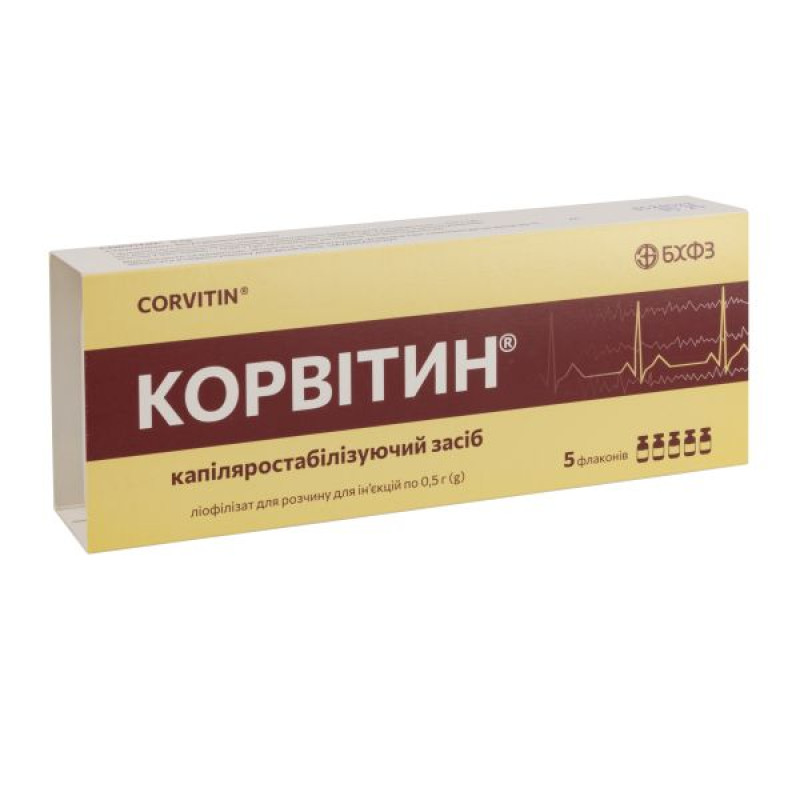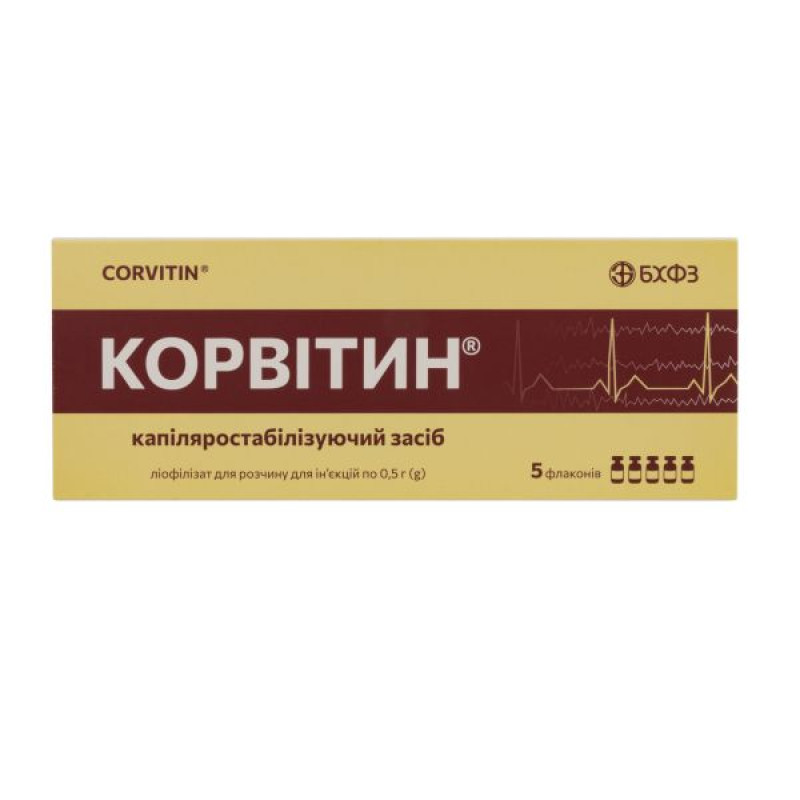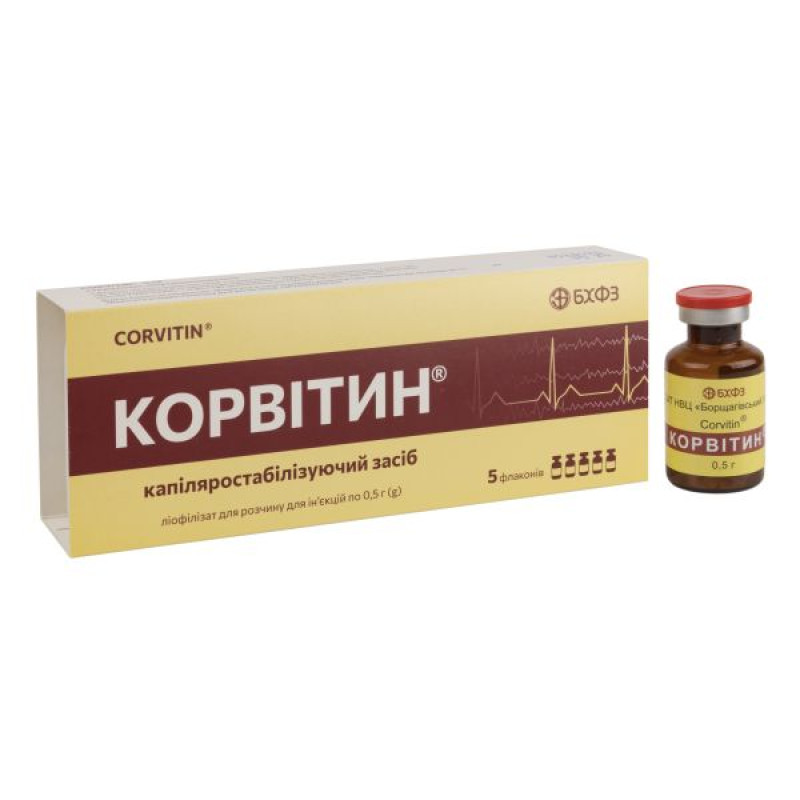Corvitin lyophilized powder for solution for injection 0.5 g bottle No. 5

Instructions for use Corvitin lyophilized powder for solution for injection 0.5 g vial No. 5
Composition
active ingredient: corvitin, which is a complex of quercetin with povidone;
1 bottle contains Corvitin, which is a complex of quercetin with povidone – 0.5 g, which is manufactured according to the recipe: quercetin (calculated as 100% dry matter) – 0.05 g, povidone with a molecular weight of 7100-11000 (calculated as anhydrous matter) – 0.45 g;
excipient: sodium hydroxide.
Dosage form
Lyophilisate for solution for injection.
Main physicochemical properties: dry porous mass from light yellow to yellow with a greenish tint, hygroscopic.
Pharmacotherapeutic group
Capillary stabilizing agents. ATX code C05C X.
Pharmacological properties
Pharmacodynamics.
Quercetin, which is part of the drug, has the properties of a modulator of the activity of various enzymes involved in the degradation of phospholipids (phospholipases, phosphogenases, cyclooxygenases), which affect free radical processes and are responsible for the cellular biosynthesis of nitric oxide, proteinases. The inhibitory effect of quercetin on membranotropic enzymes and, first of all, on 5-lipoxygenase affects the inhibition of the synthesis of leukotrienes LTC4 and LTB4. Along with this, quercetin dose-dependently increases the level of nitric oxide in endothelial cells, which explains its cardioprotective effect in ischemic and reperfusion heart damage. The drug also has antioxidant and immunomodulatory properties, reduces the production of cytotoxic superoxide anion, normalizes the activation of the subpopulation composition of lymphocytes and reduces the level of their activation. By inhibiting the production of pro-inflammatory cytokines IL-1b and IL-8, the drug reduces the area of necrotic myocardium and enhances reparative processes.
The protective mechanism of action of the drug is also associated with preventing an increase in the concentration of intracellular calcium in platelets and activation of aggregation, and with inhibition of thrombogenesis processes.
The drug restores regional blood circulation and microcirculation without noticeable changes in vascular tone, increasing microvascular reactivity.
Corvitin® normalizes cerebral hemodynamics in ischemic lesions, reduces the coefficient of asymmetry of cerebral circulation in ischemic stroke.
Clinical trials
The study of the effectiveness of the sequential use of the drugs Corvitin and Quertin as pathogenetic treatment of pneumonia associated with COVID-19 coronavirus infection, against the background of basic therapy, was conducted as part of a clinical study: "An open, multicenter, randomized study to study the effectiveness of the drug Corvitin, lyophilized powder for preparation of injection solution 0.5 g, manufactured by PJSC NVC "Borshchagivskyi HFZ" with the subsequent use of the drug Quertin, chewable tablets 40 mg, manufactured by PJSC NVC "Borshchagivskyi HFZ" in patients with pneumonia associated with 2019-nCoV acute respiratory disease, against the background of basic therapy." The study involved 200 adult patients of both sexes.
The results of the study proved the predominant effectiveness in the main variable, which was defined as the time to normalization of most of the symptoms of the disease. Thus, the addition of the drugs Corvitin® and Quertin to the basic therapy leads to an increase in the saturation level and an acceleration of recovery (by 2 days) compared to the control group.
Due to its membrane-stabilizing, antioxidant, and endothelium-protective effects, the use of the drug Corvitin with the subsequent use of the drug Quertin against the background of basic therapy helps stabilize the level of D-dimer in the blood of patients with pneumonia associated with coronavirus disease.
Pharmacokinetics.
Clinical studies involving healthy volunteers
The therapeutic efficacy of the studied drug Corvitin® is due to the pharmacological effects of quercetin (free, total, conjugated) and its active metabolites (free, total and conjugated isorhamnetin). Free quercetin undergoes 32.5% conjugation within 20 minutes after administration. Isorhamnetin also undergoes 70% conjugation within 25-30 minutes. Tmax of total and free quercetin is 0.25 hours, Tmax of free isorhamnetin is 0.27 hours.
T½ of free quercetin is 1.08 hours, free isorhamnetin – 0.18 hours, T½ of total quercetin, conjugated quercetin, total isorhamnetin, conjugated isorhamnetin and the total concentration of quercetin and isorhamnetin is significantly higher (6.92; 6.90; 4.39; 4.40; 5.80 hours). At the same time, Kel of quercetin and its metabolites shows inversely proportional values. The highest Cmax was recorded in the total concentration of quercetin and isorhamnetin and is 3870.9 ng/ml, the lowest Cmax was observed in free isorhamnetin (251.6 ng/ml). After parenteral administration of Corvitin®, the studied drug was excreted in the urine in the form of quercetin and isorhamnetin conjugates.
Thus, the pharmacokinetic parameters of the drug can be considered as follows:
| Cmax (ng/ml) | Tmax (hours) | AUC0—t | AUC0—¥ | AUC0-t (%) | Kel | T1/2 (hours) |
|---|---|---|---|---|---|---|
| 3870.9 | 0.25 | 4136.8 | 4595.9 | 90.87 | 5.23 | 6.92 |
Indication
Complex therapy for acute coronary syndrome and myocardial infarction.
Complex therapy for decompensated chronic heart failure.
Complex therapy for acute ischemic stroke (ischemic stroke, transient ischemic attacks) and chronic ischemic brain diseases.
Treatment and prevention of reperfusion syndrome during surgical treatment of patients with obliterating atherosclerosis of the abdominal aorta and peripheral arteries.
As part of the complex treatment of pneumonia caused by COVID-19 coronavirus infection in adults.
Contraindication
individual sensitivity to quercetin and/or other components of the drug;
hypersensitivity to drugs with P-vitamin activity;
severe arterial hypotension.
Interaction with other medicinal products and other types of interactions
In combination with organic nitrates, CorvitinÒ may cause arterial hypotension. Simultaneous use of the drug with fibrinolytics leads to increased effectiveness of thrombolytic therapy.
Do not use glucose, rheopoliglyukin and other solutions as a solvent for the drug CorvitinÒ.
The drug is used in combination with antianginal, antiarrhythmic, antiplatelet and fibrinolytic agents.
When using the drug:
with ascorbic acid preparations – summation of effects is observed;
with nonsteroidal anti-inflammatory drugs - the anti-inflammatory effect of the latter is enhanced while the ulcerogenic effect is reduced;
with digoxin – the maximum concentration in blood serum and the total area under the “concentration-time” curve of digoxin increase;
with cyclosporine – increases the bioavailability and blood concentration of cyclosporine;
with paclitaxel – effect on the metabolism of the latter;
with verapamil – the bioavailability of the latter increases;
with tamoxifen – bioavailability increases, metabolism and excretion of the latter decrease.
Application features
Administer intravenously by drip.
Corvitin® should not be administered simultaneously with other medicinal solutions!
The drug is used in combination with antianginal, antiarrhythmic, antiplatelet and fibrinolytic agents.
When treating patients with pneumonia caused by COVID-19 coronavirus infection, Corvitin® is used in combination with basic therapy drugs, followed by a switch to taking the drug Quertin.
Use during pregnancy or breastfeeding
It is not recommended to use the drug during pregnancy.
If it is necessary to use the drug, it is recommended to stop breastfeeding for the period of treatment.
Ability to influence reaction speed when driving vehicles or other mechanisms
There is no information on the ability of Corvitin® to affect the reaction rate when driving or working with other mechanisms.
Method of administration and doses
Solution preparation
The solution is prepared in two stages:
Stage 1 – for the initial dissolution of the drug, inject 15 ml of 0.9% sodium chloride solution into the vial with Corvitin® with a syringe, shake the vial until the lyophilized powder is completely dissolved.
Stage 2 – transfer the resulting solution to a container with 0.9% sodium chloride solution, the total volume of the finished solution is 50-100 ml, depending on the indications.
If it is necessary to administer 1 g of Corvitin®, transfer the initially dissolved preparation from two vials to a container with 0.9% sodium chloride solution, the total volume of the finished solution is 50-100 ml.
Do not mix with other solutions and drugs! Do not use syringes and intravenous systems that have previously been used for other drugs.
Corvitin® should be diluted immediately before administration! It is not recommended to use a solvent in a volume of more than 100 ml, since with an increase in the volume of the solvent, the potential risk of reducing the stability of the prepared solution increases.
Corvitin® application regimens in complex therapy
| Indication | 1 day | 2-3 days | 4-5 days | from 6 to 10 days inclusive |
Acute myocardial infarction myocardium (volume of solution per 1 injection – 50 ml; inject within 15-20 minutes) | 1 injection – 0.5 g after hospitalization, 2 injections – 0.5 g in 2 hours, 3rd injection – 0.5 g 12 hours after the last injection | 0.5 g 2 times a day with an interval of 12 hours | 0.5 g once a day | - |
Decompensation chronic heart disease deficiencies (volume of solution per 1 injection – 50-100 ml; administer over 15-20 minutes) | 1 injection – 1 g after hospitalization, 2 injections – 0.5 g in 12 hours | 0.5 g 2 times a day with an interval of 12 hours | 0.5 g once a day | - |
Acute ischemic stroke (volume of solution per 1 injection – 50-100 ml; administer within 15-20 minutes) | 1 injection – 0.5 g after hospitalization, 2 injections – 0.5 g in 2 hours, 3 injections – 0.5 g 12 hours after the last administration | 0.5 g 2 times a day with an interval 12 hours | 0.5 g once a day | |
Reperfusion syndrome in surgical treatment of patients with obliterating atherosclerosis of the abdominal aorta and peripheral arteries (volume of solution per 1 injection – 100 ml; administer within 15-20 minutes) | 1 injection – 0.5 g 10 minutes before removing the clamp from the aorta, 2 injections – 0.5 g in 12 hours | 0.5 g 2 times a day with an interval 12 hours | 0.5 g 2 times a day day with an interval of 12 hours | - |
Pneumonia caused by COVID-19 coronavirus infection (volume of solution per 1 injection – 50–100 ml; inject within 15–20 minutes) | 0.5 g 2 times a day with an interval 12 hours | 4th day: 0.5 g 2 times a day with an interval 12 hours; Day 5: 0.5 g once a day | 0.5 g once a day* | |
* - With subsequent transition to the use of the drug Quertin according to the scheme.
Children.
There is no experience with the use of the drug in children.
Overdose
Cases of overdose with Corvitin have not been described. It is possible that side effects may be exacerbated.
Adverse reactions
With rapid intravenous administration or when used in combination with organic nitrates, transient moderate arterial hypotension may occur. The following adverse reactions have also been noted:
nervous system: dizziness, headache, numbness of the tongue, tremor, chills, tinnitus, agitation or general weakness, paresthesia (tingling sensation) of the extremities;
immune system, skin and subcutaneous tissue: allergic reactions, including rashes, including urticaria, itching, anaphylactic shock;
cardiovascular system: tachycardia, chest pain, facial flushing;
others: difficulty breathing, shortness of breath, nausea, vomiting, hyperthermia, changes at the injection site (hyperemia).
Expiration date
2 years.
The drug solution remains stable at 25 ºC when diluted in 50 ml of 0.9% sodium chloride solution – 12 hours, in 100 ml – 6 hours.
Storage conditions
In the original packaging at a temperature not exceeding 25 °C.
Keep out of reach of children.
Incompatibility.
Do not use glucose or rheopoliglyukin solutions as a solvent for the drug CorvitinÒ. Only 0.9% sodium chloride solution is used as a solvent.
The drug CorvitinÒ cannot be administered simultaneously with other drug solutions.
Packaging
1 bottle per pack.
5 vials in a cassette, 1 cassette in a pencil case.
Vacation category
According to the recipe.
Producer
Public Joint Stock Company "Research and Production Center "Borshchagov Chemical and Pharmaceutical Plant".
Location of the manufacturer and its business address
Ukraine, 03134, Kyiv, Myru St., 17.
There are no reviews for this product.
There are no reviews for this product, be the first to leave your review.
No questions about this product, be the first and ask your question.










